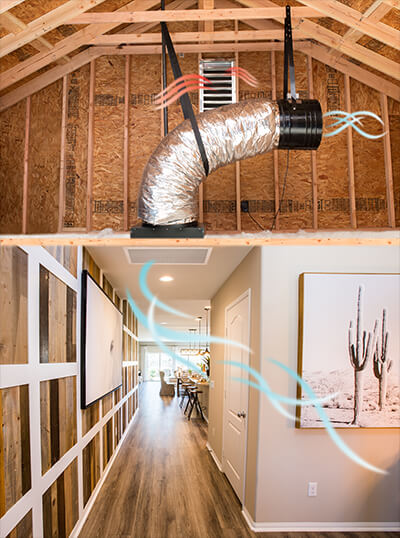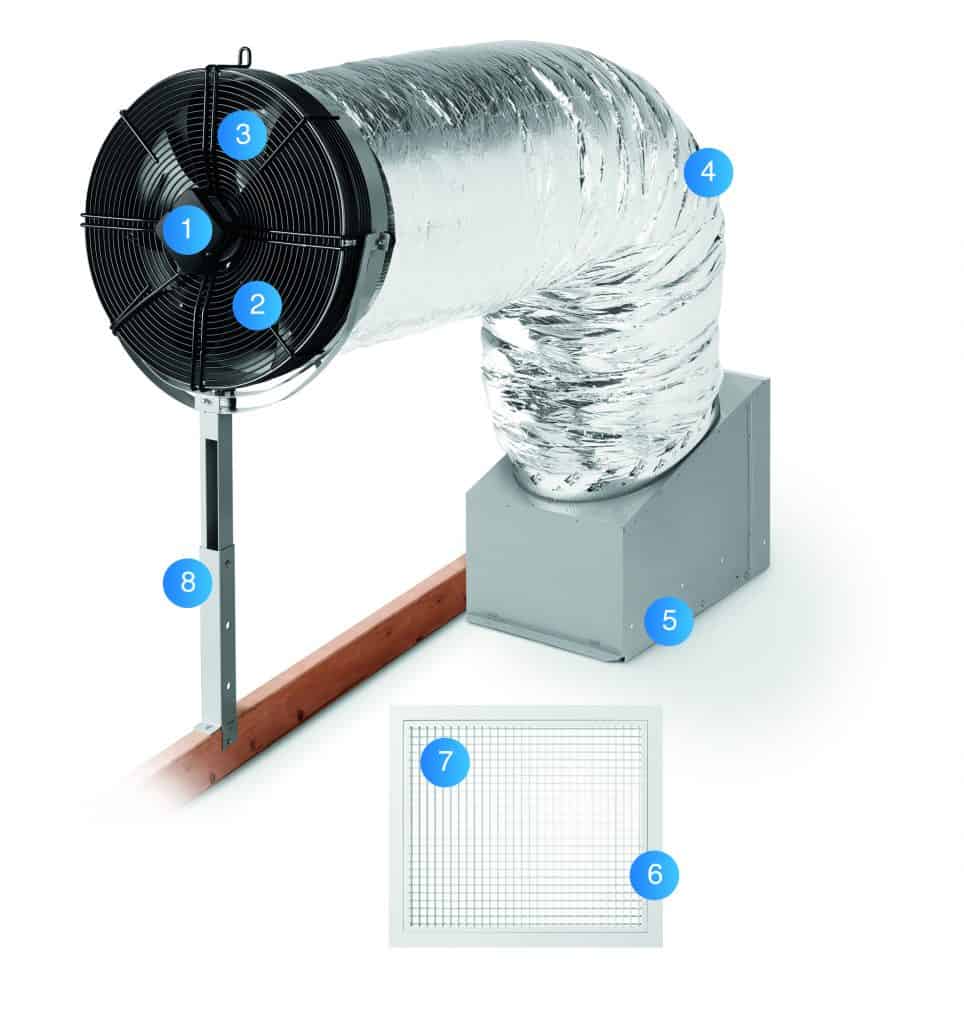Table Of Content
- Attic Ventilation Requirements
- Best Remote Control-Operated Fan
- Considerations for Choosing and Installing a High-Velocity HVAC System
- QuietCool 6878-CFM Energy Saver 24-in Steel Single Direct Drive Whole House Fan
- Things to Consider When Installing a Whole House Fan
- ATTIC FANS
- Editor’s Choice “Insulated”: “Tamarack” – HV1000 R-38 Insulated Fan

Larger fans do tend to be a bit noisier though, so keep that in mind, as well. You should also remember that some whole house fans will require an electrician to wire them up, which will need to be included in your overall budget. This picture shows the air quality in the home after running a whole house fan for 10 minutes. You can see how the whole house fan significantly improved the home’s indoor air quality score. You can see the VOCs, PM 2.5, dust and carbon dioxide levels improved dramatically within just a few short minutes.
Attic Ventilation Requirements
These kinds of fans have insulated doors that shut tight when the fan is not in operation. While a whole house fan brings in outdoor air, it can potentially introduce dust or allergens into the home. To minimize this issue, homeowners can use window screens to filter incoming air and can schedule the fan’s use during times when outdoor air quality is good. Some modern whole house fans come with filters that can help to reduce the introduction of outdoor pollutants.

Best Remote Control-Operated Fan
As in all of the QuietCool fans, it also has pressurized gravity dampers to give it a tight seal when not in use. This QuietCool ducted whole house fan is hung from the attic rafters (instead of installed in the ceiling) which can greatly reduce noise and vibrations. While the price of either type of motor can vary significantly depending on cost factors like CFM, diameter, and brand, belt-drive models tend to be more affordable up-front. If your fan doesn't come with a tight-sealing winter cover, you should either buy one or build one. This makes the whole house fan installation easier and the operation very quiet.
Considerations for Choosing and Installing a High-Velocity HVAC System
For a 1,500-square-foot house, the direct-drive 24-inch unit, which covers 4,500 CFM, is recommended. A whole-house fan timer control is recommended over a thermostat, because a thermostat can turn the fan on when no one is home (i.e., no windows or doors are open). In addition, a fire in the fireplace could trigger the fan to go on if it’s controlled by a thermostat.

Fuller House: Michelle Died In Full House — Theory Explained - Screen Rant
Fuller House: Michelle Died In Full House — Theory Explained.
Posted: Tue, 19 Dec 2023 08:00:00 GMT [source]
Electrical permits cost between $10 and $500, depending on the project. The price of a whole-house fan ranges between $600 and $1,500 on average, though you can find small models for as little as $400 and large, premium models for as much as $2,600. Remember, the installation involves using power tools, ladders, and possibly new electrical wiring or attic framing. Models such as the Quiet Cool Smart Gable mounted fan are, in our opinion, the most modern, efficient, and quiet in-line whole-house fan you can buy for your home. You can check the current whole-house fan cost for the Quiet Cool whole-house fan, via the link below.
Things to Consider When Installing a Whole House Fan
The fan is connected to a vent in the ceiling by a duct that will open or close when the whole house fan is operating. Since the whole house fan isn't in the ceiling, they tend to make much less noise and vibrations. These whole house fans come in 4 different models with a low CFM of 1400 and up to ~5000-cfm. These ducted whole house fans are very similar to the Energy Saver Quiet Cool fans except that it uses a 2-speed PSC motor instead of a 2-speed ECM motor.
Advanced Whole House Fans work in almost every climate zone, even in high humidity or desert climates. With an Advanced Whole House Fan, builders are using smaller solar systems, better rated insulation, and an Advanced Whole House Fan to reach a net zero home. A properly sized Advanced Whole House Fan is very important for homeowners to get the maximum benefits. Fresh air is wonderful, but a constant, loud hum or chatter from a whole-house fan can be disruptive. For those who are sensitive to noise, some fans are better choices than others.
This phenomenon is known as the “stack effect” because your home almost acts like a chimney stack. Energy Department, a whole house fan should move about air changes per hour which will vary based on your climate, the layout of your house, and other factors. Countdown timers allow you to turn on a whole house fan and automatically have it shut off in 15-minutes or a time of your choice. The windows don't need to be totally open, 4-5 inches should be sufficient.
Door fans come with insulated (R-22 or R-38) panels that open every time you turn the fans on. This feature not only helps during winter months but also keeps heat out during the summer when you’re running your AC. Thanks to its powerful 3,945 CFM airflow, this fan is capable of cooling two-story homes up to 3,400 square feet in size. We’re also a big fan of its impressive warranty, covering parts for three years, and the motor for 10 years. This climate zone allows whole house fan usage during Spring, Fall, and Winter.
A fan won’t work if the hot air doesn’t have an easy way out; without adequate ventilation the fan may force hot air down on you! If you don’t want to install additional venting, it may make sense to stick with a smaller fan. Its high-quality construction also makes this an especially sturdy model, and its rubber bushings help to reduce vibration and noise, keeping its operating level at about 51 decibels. Solid foam dampers flip into place and form a tight seal when the system is not in use, preventing warm air seepage and increasing its overall efficiency. A multi-room or also known as a zoned system is a Advanced Whole House Fan that is a bigger, stronger version of this type of ventilation system that can cool more than one room at once.
If the weather turns nasty, no worries—the Air King has a Storm Guard that lets you close the window with ease. By using a quality, properly installed house fan, the sound of your fan is hardly noticeable. Even light sleepers can enjoy a good night’s sleep in your quiet (and cool) house.
If you’re considering an exhaust fan for your house, the standard whole-house fan option is The least expensive and most powerful whole-house fan. Standard exhaust fans are large (up to 30″) and can produce as much as 4,000 – 6,000 cubic feet of air exchange per minute. You must ensure all your windows are open – first, and turn on the fan, which removes the heated air and replaces it with cool outside air. Whole-house fans can be controlled by a manual switch or by an automatic timer.
And yet, whole house fans are still incredibly effective — especially when the outdoor air is cooler than the home’s interior, such as when the air cools at nighttime. A whole house fan is a high-powered vent fan, usually installed on the top story hallway ceiling—that sucks out the hot air from the inside to the outside. The central home fan pushes the hot air through the attic, and to the outside (through the roof vents). Fully installed, a whole-house fan ranges between $900 and $2,500, while central air conditioning costs much more at $3,880 to $7,900. However, belt-drive motors have more moving parts, making them more prone to malfunctioning.
Just like other QA models, this fan is designed to comfortably fit between both 16- and 24-inch on-center joists, so no framing will be necessary during installation. A separate control panel features an easy to read LCD screen, which shows the desired temperature as well as the actual temperature, and allows you to set timers and alarm warnings. It also gives the option of choosing between 10 speed settings, which is considerably more than similar options. QuietCool makes the best Advanced Whole House Fan but It’s hard for me to say which Advanced Whole House Fan model is the best.
Make sure to open windows in the locations that you want the breeze to come from. An Advanced Whole House Fan is most effectively used when it is run at the proper time, however, the way in which it is used is very important as well. There are many benefits that Advanced Whole House Fans bring to homeowners. An attic or whole-house fan is a very simple design, and users can expect to get around 15 years of use from a fan before having to replace it. Despite all of the information presented here on the best whole-house fan, there may still be questions about how they work. Read on for answers to some of the most common questions about whole-house fans.


No comments:
Post a Comment